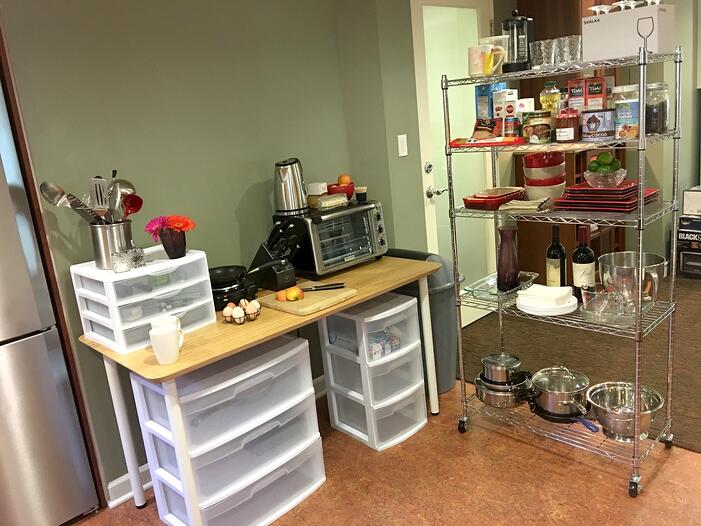Before you tear out the old kitchen, consider this: You’re cooking three meals a day without your main appliances like refrigerators or grinder. And believe me—the best way to ensure that the transition period of your remodel goes smoothly is to reduce uncertainty. This guide will help you set up a temporary kitchen so that whatever changes come during your remodel, you won’t be caught off-guard.
Prepare your list BEFORE your demolition begins ensures nothing gets forgotten!
Before you start packing up your kitchen, come up with a plan. The last thing you want to do is search for something in storage that you may have forgotten you needed.
Here’s are some ideas of what you may need:
- A microwave
- One burner (e.g., hot plate or small propane stove)
- Coffee maker (if not already included with hot plate or stove)
- Toaster
- Blender, mixer, or hand-mixer
- Plates, drinking glasses, utensils, and silverware.
- Pots and pans (at least 1 for each person you’re cooking for)
- Dish soap and scrubber
- Trash bags
NOTE: You may want to include paper towels, napkins, or moist wipes in your list. They could be useful during the transition period because you will not have an opportunity to do laundry until after your renovation is complete.
Pick a convenient location for the temporary kitchen.
Find a dedicated space for the temporary kitchen, such as an unfinished portion of your basement or unused living room. Or you may need to develop a plan for integrating the temporary kitchen into your current set-up (i.e., at the end of an island or peninsula or in a corner away from foot traffic).
Selecting a place near where you’ll be doing all of your cooking will make things easier on yourself and make it feel less like you’re eating takeout every day (which is not very fun with kids in the house!).
Don’t forget your power supply. A room without an outlet near the temporary kitchen is good for nothing.
A folding table works well
Set up a 6-foot or 8-foot folding table instead of a cambria counterrtop and organize your small appliances on top. Try to keep the ones you will use daily easily accessible.
Simple plastic shelving under the table works well to organize pots, pans, silverware.
Depending on how long you’re setting up the temporary kitchen, invest in some plastic shelving units. This will allow you to stay organized and easy-to-find what you need when cooking. For example, place all pots and pans on one shelf, baking trays on another, and so forth.
Try to keep the same routine as you do in your permanent kitchen.
Create a simple washing and dry station
Using disposal plates and silverware will get cumbersome fast. Keep a small set up dinner plates, silverware, and drinking glasses easily accessible. One of each item for every member of your family will suffice.
If space allows, set up a smaller 4ft folding table in a nearby powder room will work well for washing and drying dishes. Especially since you will have to do this after every meal.
Purchase a small drying rack and place a towel underneath so dripping water doesn’t damage floors.
Have a temporary pantry ready for quick meal prepping
Having a pantry ready with the essentials will make it easier for you and your family.
Make sure there’s at least one shelf full of easy-to-grab snacks that everyone likes: Chips, bread, crackers, cereal, etc.
A large box of pasta or rice is another must. It can be used as an ingredient for many different dishes throughout the transitional period. It’s also lightweight and relatively inexpensive so there’s no need to pack it up when you move out of your temporary kitchen.
Keep a few boxes of flavored oatmeal packets for breakfast or easy snacks on hand as well. You’ll thank yourself later!
If space allows, keep boxed stock (e.g., chicken stock) on hand for impromptu dinners or recipes. You’ll be surprised how much of a difference it can make to have some on hand during the transitional period.
A large bag of coffee, filters, and basic spices are also essential ingredients to keep an eye on so you don’t run out of them before your renovation is complete.
Remember, it’s not about convenience or comfort
Setting up a temporary kitchen is critical for long-term kitchen remodeling projects. Not having one adds a ton of stress and pressure on you and your family. Keep in mind, it’s not about convenience or comfort. It’s about necessity. You don’t need to spend a lot of time or money setting this up but you do need to have the essentials.

